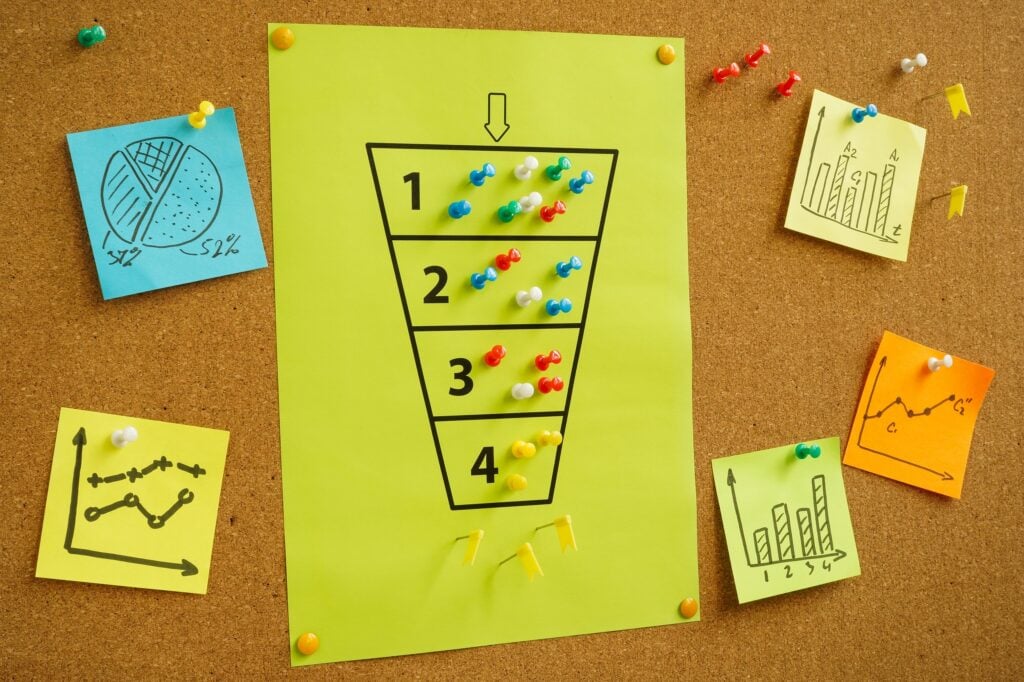Every growing business needs a sales funnel. They hold the key to converting the people who engage with your business into paying, loyal customers.
A well-defined sales funnel will help you understand what your potential customers are thinking and doing at each stage of the buying journey. With this insight, you can tailor your marketing activities to their needs and create compelling messaging to build trust in your brand and convert more prospects into paying customers.
A sales funnel steers the journey your customers go through, from initially discovering your business and finding out more about your products and services right through to conversion and purchasing.
Providing a memorable experience to keep them engaged and nurture them through every stage will result in increased sales, greater customer satisfaction and more repeat business.
Here, we take a closer look at what sales funnels are and why you need one to grow your business.
What are sales funnels, and what are they used for?
Sales funnels are an essential part of any business’s marketing strategy. They are a marketing technique used to generate leads and convert them into customers.
They comprise a series of steps designed to capture the attention of a sales prospect and nurture them through the buying process.
Sales funnels are used in both B2B and B2C marketing. They are especially useful in B2B businesses, where leads can often take longer to convert.
A sales funnel has several main components, which can be simplified as follows.
The first is to capture the lead’s contact information. This can be done in several ways, including a simple lead capture form on your website, a dedicated landing page, or by offering a free download – known as a lead magnet – in exchange for their contact information.
Once you have captured their contact details, the nurturing process begins. At the start of this phase, your prospects are like fragile seedlings. You need to nurture and grow the relationship and build trust and engagement by offering additional advice and content, reviews, testimonials and case studies, and other material that helps build trust and credibility. This will help you qualify their intent, as the longer they stay in the funnel and engage with the content you send them, the more likely they’ll be to buy later down the line.
The next step is to introduce your offer – usually a product or service – and explain how it can solve the customer’s problem. At this stage, it’s important to keep the prospect engaged through a series of communications designed to provide more information about the offer and your business to build trust and credibility.
Once you’ve warmed up the prospect enough to convince them to buy, the last step is to convert the lead and close the sale. After the deal is completed, you should focus your efforts on providing excellent service and building relationships with customers so they become long-term, loyal brand advocates.
The different types of sales funnels
Sales funnels are a powerful way to organise your sales process and drive more leads through your customer journey. They can help you identify which stage of the buying process a prospect is in, and what actions need to be taken to move them closer to making a purchase.
Sales funnels are a great way to grow your business. They can be used for a variety of purposes, such as growing an email list, selling products or services, or even just getting more subscribers.
There are three main types of sales funnels: awareness funnels, consideration funnels and purchase funnels.
As the name suggests, awareness funnels are used to drive awareness and interest in your business. They are often used to generate initial leads from people who are interested in similar products or services you offer.
Consideration funnels are used to develop trust and build relationships with potential customers. They are great for getting people to decide that they want to try a product or service for themselves and to provide them with more information about it.
And purchase funnels are used to convert leads into sales. They typically include the steps involved in closing a sale.

Why do you need a sales funnel?
Sales are the lifeblood of most businesses. Without a steady stream of new customers – or sales opportunities – you won’t create the revenue you need to sustain or grow.
Sales funnels are an effective way of addressing that problem. They are about creating and nurturing a pool of potential customers, who are interested in what you do.
To use a fishing analogy, it’s like creating your own lake and stocking it up with your favourite fish, so every time you are hungry, you can cast your net. The best part is, if you’ve nurtured your fish correctly and kept them engaged, you’re guaranteed a catch every time.
In the pre-social media and ecommerce days, marketing theory suggested the ‘rule of seven’ – that a potential customer must see a marketing message at least seven times before they’ll be provoked into taking action. These days, depending on who you listen to, that number varies from anything between 12 to 21.
Social media, paid ads, SEO and remarketing techniques make it possible to create those touchpoints across multiple digital channels, to present your message several times to people who have shown interest in your products and services.
A dedicated sales funnel will help you capture these prospects and start nurturing them through a defined process, rather than relying on scattergun marketing to bring people to your business.
With a sales funnel, you can bring laser-like focus to your marketing, so you’re not wasting time or money chasing leads you have no realistic prospect of closing. It’s like having a personal lake full of the right kind of fish, that just need reeling in. The other benefits of having a dedicated sales funnel include:
Increased sales
The main objective of a sales funnel is to increase sales. It’s to help you attract more qualified leads to your business, keep them engaged with your brand and build trust until they reach the point when they’re ready to buy from you. Once you have leads in your sales funnel, you can focus your efforts on sales-generating activities, refine your processes to iron out any issues which cause people to drop off, and introduce ways to generate more revenue per lead.
Improved forecasting
The data you get back from your sales funnel can help make forecasting more straightforward so that you can make better decisions about cash flow, budgeting and inventory. For example, if you know that around 15% of the people who sign-up for your lead magnet convert, and it usually takes them four weeks to move through the funnel, you can accurately estimate how many sales you’ll make each month, based on the number of new subscribers you get.
Greater profitability
Once your sales funnel is up and running and performing as it should, you can begin looking at ways to improve your margins and increase your profits. It will give you a better idea of how you acquire leads, how much you spend to acquire them, and where improvements can be made.
For example, if you’re using paid ads on both Google and LinkedIn to attract prospects, but it costs you £10 per lead on LinkedIn but only £8 on Google, you can focus more of your spend on Google Ads to generate better returns. Likewise, if you’re finding that one platform is converting leads at a higher rate than the other, you can tweak your activities accordingly to optimise the platforms that are performing best, to maximise the returns.
Continuous improvement
It’s not just sales that your funnel is vital for. It can help you improve your product development and delivery, too. Again, your sales funnel will give you valuable insight into how you can enhance your products and services and how you present them through your marketing. By identifying and addressing any weaknesses in your offer, based on what your sales funnel is telling you, you can focus your efforts on giving customers exactly what they need.

Common sales funnels mistakes businesses make
Sales funnels are one of the most important aspects of any business, yet they are often misunderstood and misused. There are many common mistakes people make with their sales funnels, including:
Not creating a strong lead magnet
A lead magnet is a valuable piece of content you offer potential customers in exchange for their contact information. It can be anything from a free eBook or whitepaper to a video tutorial or a set of exclusive discounts.
Your lead magnet needs to be strong enough to create an interrupt – something that makes people stop what they’re doing to pay attention to the marketing message. If your lead magnet is not strong enough to attract attention and prompt clicks to your landing page or data capture form, your sales funnel won’t be as effective as it could be.
Not following up
Another mistake many people make when trying to generate leads is not following them up. If you’re using an automated sales funnel, this is an easy one to avoid because as soon as the prospect enters their contact details, they’ll be in your email system and start receiving emails automatically. However, if you’re manually collecting leads – business cards at an event, for example – then following them up straight away, or getting them into your email system so they can start receiving automated content, is vital.
Once you’ve got a prospect’s details, be proactive. Connect with them via LinkedIn, drop them a personalised message, or reach out to them with a direct email. It might not get you the sale there and then, but it will help you create a personal connection, develop the relationship and start building trust and rapport.
Not using emails correctly
Once you’ve captured the prospects’ contact details, emails are the best way to nurture leads and convert them into customers during the engagement stage. However, many people make the mistake of sending too many or too few emails, or not personalising them enough. A good email chain should be engaging enough to hold people’s attention and regular without being ‘spammy’, with each message having clear intent to nudge the customer further along the buying process until the sale is closed.
Focusing on the wrong things
Many businesses focus on generating more leads rather than converting their existing ones into customers. Once you have prospects in your sales funnel, each message you send them should be focused on moving them closer to the sale rather than introducing new information that may confuse what it is that you want them to do.
Not building trust
Nurturing a lead takes time. While the prospect may be interested in your product or service, they probably won’t be ready to buy until they fully trust your brand or business. So, once you’ve qualified the leads, the main aim of your messaging is to keep them engaged with your brand and build trust and credibility as you nurture them along the journey. Sharing testimonials, customer reviews, accreditations and links to media coverage in credible sources are all great ways of building that initial trust with prospective buyers.
Get a sales funnel from QBD
Whatever your sales goals, a sales funnel from QBD can help you achieve them. We’ll work with you to understand your ambitions before creating a tailored sales funnel that meets your needs.
We have a range of industry-leading tools – including ClickFunnels™ – at our disposal, with expertise in all of them, to deliver more leads and sales. We have an inherent understanding of buyer behaviour and the psychology of how sales funnels work for different target audiences, markets and sectors, to help maximise their effectiveness, whatever your business does.
We also provide ongoing strategic marketing consultancy, creative design and content, and digital growth support to optimise your sales funnel activities and ensure they’re working as hard for you as possible. Get in touch today to find out more.

